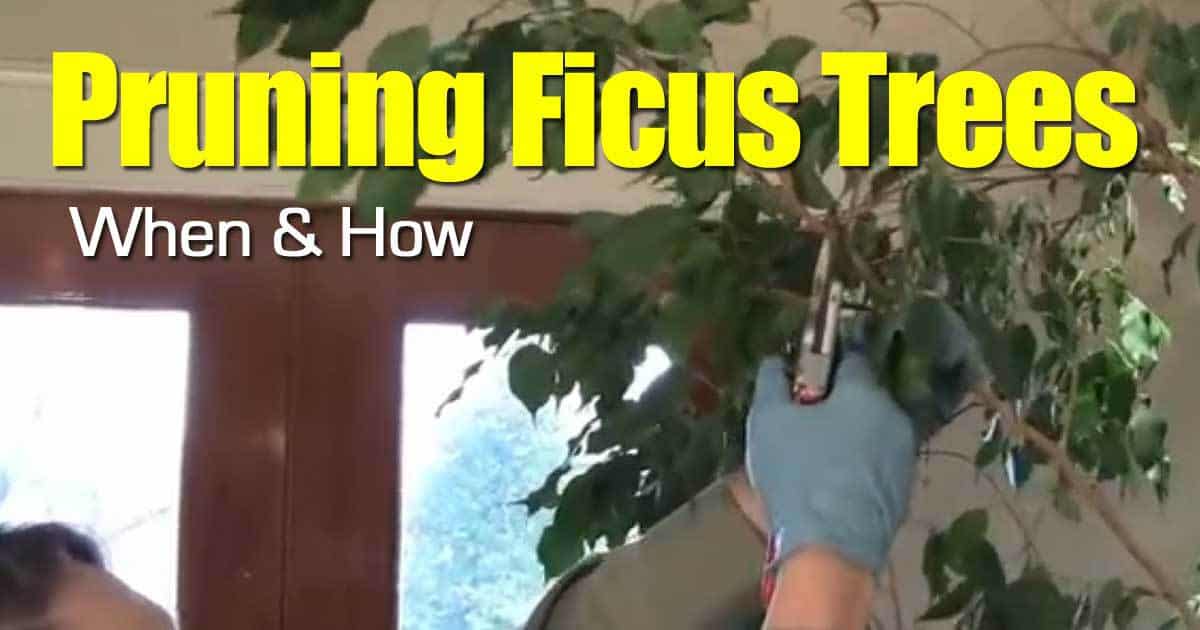What is a Ficus tree? Ficus trees, also known as ficus benjamina, weeping fig tree or the benjamin fig, have a tendency to freak people out… It seems like as soon as the ficus tree comes home, leaves start dropping.

The last thing a Ficus tree owner was to think about is pruning.
There are too many visions of leaf drop in their mind.
There are newer varieties of Ficus trees which hold their leaves much better.
Ficus Tree Cultivars like the:
- Ficus microcarpa (Chinese banyan)
- Ficus nitida (Indian laurel)
- Ficus elastica (rubber plant or rubber tree)
- Ficus lyrata (fiddle leaf)
- Fcus retusa (ginseng ficus)
- Ficus maclellandii (Alii Ficus)
- Ficus neriifolia
… are even grown like indoor bonsai trees in pots.
Ficus Tree Care Hate Mail
Before I get too far I need to really get something off my chest relating to the Ficus tree and Ficus growers.
I’m sure “hate” mail will soon be following.
The weeping fig ficus benjamina continues to be a major crop for indoor use. At one point in my foliage growing career I grew over 125,000 plus Ficus plants per year. The issue I have with SOME, not all, Ficus growers is with pruning or trimming a Ficus tree!

Economics being what they are, it’s financially cheaper to prune a Ficus with hedge clippers.
Just get out the clippers and make all the plants the same height. That’s the problem – using hedge clippers is NOT the correct way to prune a Ficus Benjamins tree.
Plants much like people and none of these Ficus growers would dare to have their hair cut the same way they “trim” their Ficus crop! If you want the right results you need the correct method.
I’ve always hand pruned my Ficus tree crops all 125,000 plus of them.
I’ll admit I tried the shear method and all it does is promote a disease called Phomopsis. What Phomopsis causes is twig dieback and under indoor conditions it can get very severe.

GROWERS if you are not going to prune Ficus trees correctly – please quit selling them to the public. You’re only creating headaches! I feel better now…
Here’s what happens. You’ll notice on a Ficus tiny “branches” with a node between them.
If you just randomly cut between these nodes (this happens when you shear), the twig dies Phomopsis.
A correctly pruned Ficus tree plant won’t miss a beat. It may have lost some foliage but it will immediately begin to sprout out and grow.
This shrub is also good for bonsai training. The ficus benjamina bonsai features shiny leaves, ideal height, and sturdy trunks.
If you prefer a bonsai ficus, then this cultivar makes a perfect choice.
Next time you’re in the local garden center take a good look at the Ficus benjamina and see if you can find what I’m describing.
How To Trim A Ficus Tree Basics
Learn how to prune a ficus tree.
When Ficus pruning is done correctly can extend its life… proper pruning will also extend the useful life of many indoor plants. Pruning helps:
- Control or maintain shape and size
- Promote growth
- Allow more light and air to the plant
- Remove dead, diseased or pest infested foliage
youtube” video_url=”https://www.youtube.com/watch?v=s5UPE-5V-ug
Let’s assume your Ficus bonsai tree has outgrown the space and you need to reshape it.
Start by removing all the dead twigs on the tree. Ficus are lovers of light.
As some of the smaller inner branches are shaded out they just die – this is natural. These twigs will generally be very small about the size of a #2 pencil lead.
Remember – Ficus are lovers of light. It’s important to get light on the foliage where the stronger branches are.
Remove any weak growth in the center of the plant.
Now it’s time to start pruning the outer growth. Remove about one-third of the canopy all the way around the tree.
What you will be doing is reducing the size of the canopy and promoting new growth and a fuller tree.

Sometimes you’ll get a “wild” branch that heads for the light and just changes the shape of the tree.
Selectively prune this branch or branches back toward the center of the tree. This will force new growth back into the center.
Root pruning is also done by owners who’d like to encourage these deciduous trees to grow back roots closer to the trunk.
Pruning Basics
- Always cut back to a healthy branch, leaving as small a wound as possible.
- Always make complete, smooth cuts; never rip or tear a branch. This leaves the plant open disease or infection.
- Never cut too far above a bud; this results in a dead stub. It looks bad and can rot back (Phomopsis) into and or past the new growth.
- Remember the tips (terminal bud) of a branch or stem grow much stronger and faster than lower buds on the branch (lateral bud). When you remove the terminal bud the strongest lateral bud takes its place.